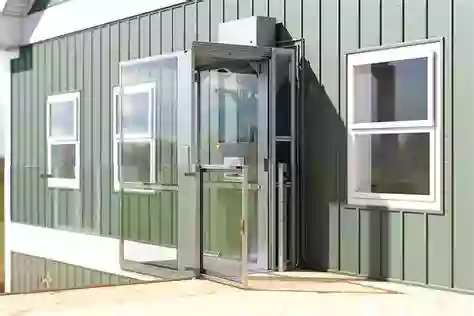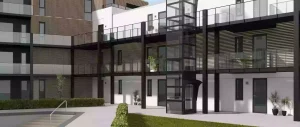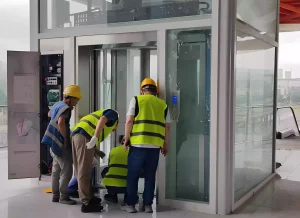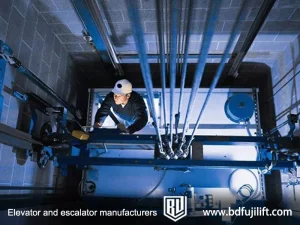If your building doesn’t have space for a shaft, or if you don’t want to use indoor space, then an outdoor elevator is very useful. With an outdoor elevator, you can connect floors without making big changes to the house, and you can even pick a style that matches how your home looks from the outside.
That’s why today, from homes to office buildings to tourist spots, outdoor elevators are easy to see almost everywhere.
But just knowing this is not enough. You also need to learn about the different types, the costs, and how installation works, so you can make the right choice. Let’s look together at what an outdoor elevator is, how much it costs, and how it is built.
What is an Outdoor Elevator?
What is an outdoor elevator?An outdoor elevator is an elevator installed on the outside of a building. Its main purpose is to make it easier to move between floors without changing the inside structure of the house.
Because the elevator works outdoors, it must be built with weather-resistant materials, sealed parts, and a reinforced shaft to handle rain, wind, and temperature changes. Depending on the design, the shaft can be made of glass, steel, or concrete.
Types of Outdoor Elevators
Outdoor elevators come in several types, each designed to meet specific building needs, heights, and space requirements. While they all perform the same basic function,their drive systems, shaft structures, and operating behaviors vary significantly.
You’ll want to choose the right option based on your home or project, the number of floors, and the kind of space you have available. Hydraulic systems are smooth and compact, traction systems are efficient for taller buildings, screw drive units are simple to install, and cable-operated lifts provide basic reliable service. Each has its own strengths and trade-offs in terms of cost, noise, and maintenance.
Hydraulic Outdoor Elevators
Hydraulic outdoor elevators use fluid pressure to move the car up and down along the shaft. They are recognized for smooth and quiet travel, which makes them comfortable for everyday use.
Because the hydraulic system does not require a large overhead machine room, these elevators can be installed even when space is limited. They are often found in private homes, villas, and other low-rise buildings with two to four floors.
One of their advantages is the gentle ride quality, but they also use more power than traction systems during long runs. Regular maintenance of the pump and fluid is needed to keep performance stable, and travel speed is generally slower compared to traction models.
Traction Outdoor Elevators
Traction outdoor elevators use ropes and a counterweight that work together to move the car. This design lowers the energy needed to lift the car, which makes the system more efficient in taller buildings.
Compared with hydraulic elevators, traction elevators travel faster and give a smoother ride over long distances. However, they are harder to install and need stronger structural support. In mid-rise apartments, office buildings, and upscale homes that value speed, comfort, and energy savings, traction outdoor elevators are a very suitable solution.
Screw Drive Outdoor Elevators
Screw drive outdoor elevators use a long rotating screw to move a nut fixed to the car platform, which raises or lowers the cab as the screw turns. This design is simple and safe, with very few moving parts, which lowers the chance of breakdowns.
Because the system is self-supporting, it does not need extra counterweights or a large machine room. These elevators are easy to install and require less maintenance than many other types. They are often chosen for small homes, villas, or low-rise buildings where travel height is limited. The main trade-off is speed, since screw drive elevators move more slowly, but in return they provide steady operation and a dependable solution for residential access.
How Much Does an Outdoor Elevator Cost?
Factors Affecting Outdoor Elevator Installation Costs
Begin by thinking about the type of project you are working on. If you are building a small home, the weight, speed, and shaft design will be very different from a mid-rise office or a glass observation tower. Each factor can change the total cost by thousands of dollars, so it is important to evaluate them carefully one by one.
An outdoor elevator may look like a high-cost upgrade at first, but the long-term value often makes it worthwhile, especially when improving accessibility or increasing property value. While the initial purchase and installation are not small expenses, the system delivers safe transport, weather protection, and convenience for many years.
Outdoor Elevator Costs are shaped by several key variables:
- Brand: International brands often cost 10–20% more than local options, but they usually include stronger warranties and better service coverage.
- Elevator type: A basic hydraulic outdoor elevator may start around $30,000, while a traction-based observation elevator with glass features can exceed $70,000.
- Load capacity & speed: Every extra 500 lbs of capacity or each jump in speed rating can add $5,000–$10,000 to the total price.
- Installation difficulty: Uneven terrain, high-rise shafts, or tight spaces can raise labor and engineering costs by 15–25% compared with simple ground-level installs.
- Regional differences: Labor rates and material prices vary, often changing costs by $5,000–$15,000 depending on the state or city.
- Shaft height & material: A simple steel frame might cost $8,000–$15,000, reinforced concrete $12,000–$20,000, while a full glass shaft can exceed $25,000.
Outdoor Elevator Cost Range
Outdoor elevator cost can vary greatly depending on the factors mentioned above. Here is an approximate cost range for different types of outdoor elevators:
- Hydraulic Elevators: These elevators are usually more expensive, with prices starting around $10,000 and can go up to $30,000 or more depending on size and features.
- Cable-Operated Elevators: These tend to be less expensive, with prices ranging from $5,000 to $15,000 for standard models.
- Simple Platform Lifts: For smaller, simpler elevators, the cost may start as low as $3,000, but the price can increase with added features or higher weight capacity.
In the U.S. market, the total installation cost of an outdoor elevator usually ranges from $30,000 to $70,000. A basic hydraulic unit for a low-rise home tends to be at the lower end, while a glass observation elevator or a premium traction model can exceed the higher end.
How to Save on Outdoor Elevator Costs
Begin by thinking about the type of project you have. If it is a small house, you may not need a high-speed traction system, and a hydraulic or screw drive outdoor elevator could be enough. For mid-rise apartments or offices, traction outdoor elevators give better speed and energy efficiency. Matching the elevator type to the building prevents overspending on features you do not need.
Design choices are another big factor. Working with architects to simplify the shaft structure can save money by lowering construction difficulty. A simpler frame can reduce total outdoor elevator installation cost by 10–15%. The way you manage elevator suppliers also matters. Asking multiple companies for bids often lowers the price by 5–20% compared with choosing the first option.
Finally, think about the future. An energy-efficient outdoor elevator may save several hundred dollars a year in electricity bills. Models with fewer complex parts reduce yearly maintenance costs, keeping service bills closer to $2,000 rather than $5,000. Over a 10-year period, these choices can make a large difference.
How to Build an Outdoor Elevator
To achieve consistent results from building an outdoor elevator, especially when facing weather conditions and structural demands, you need to apply practices that focus on accuracy, stability, and long-term safety. these practices help prevent construction errors, reduce maintenance issues, and ensure smooth operation.
Step 1: Pit Construction
A stable pit is the foundation of the entire outdoor elevator system. Depth usually ranges from 150–500 mm, and a reinforced concrete plate at least 200 mm thick is poured. The base should extend 400 mm beyond the shaft footprint to allow waterproof walls. Iron bases of 200 × 200 mm are pre-embedded at the column positions, and both the wall and the floor must be sealed carefully to block water entry.
Step 2: Shaft and Elevator Installation
The outdoor elevator shaft may be built from steel frames, reinforced concrete, or a hybrid of both. Once the pit is ready, professional installers mount the elevator system, including guide rails, traction equipment, or the hydraulic unit. Accurate alignment at this stage ensures the car travels smoothly between floors without vibration, and mistakes here can cause long-term ride issues.
Step 3: Glass Walls and Door Frame Installation
For observation outdoor elevators, glass wall panels are fixed around the shaft to create visibility and match the building’s style. Standard outdoor elevators may use steel or concrete with weather-resistant coatings. After the walls are complete, the door frames are aligned and sealed to keep out rain and wind, protecting both safety and comfort.
Step 4: Inspection and Acceptance
After construction is complete, the outdoor elevator must pass inspection and acceptance testing by local authorities or certified agencies. This process verifies that the system meets safety standards, functions correctly under load, and includes all required emergency features. Only after successful inspection can the elevator be used legally and safely.
What are the Advantages of Outdoor Elevators?
Outdoor elevators offer several key advantages that make them valuable for both residential and commercial projects. They improve accessibility by allowing easy movement between floors without major indoor remodeling. They also save indoor space by placing the shaft outside, and can increase property value by adding convenience and modern design appeal. Weather-resistant materials and sealed components ensure they can handle rain, wind, and temperature changes. For villas, offices, and tourist sites, outdoor elevators are a practical and stylish solution.
Some of the most important advantages include:
- Improve accessibility without altering indoor layouts.
- Save indoor space by moving the shaft outside.
- Add value and modern appeal to the property.
- Provide weather resistance with sealed and reinforced parts.
- Adapt to different building styles with glass, steel, or concrete shafts.
What are the Disadvantages of Outdoor Elevators?
Despite their benefits, outdoor elevators also come with disadvantages you should consider. Because they are exposed to weather, they usually require more frequent maintenance, including checks on sealing, lubrication, and electrical parts. Installation can become complex when dealing with uneven terrain or tall shafts, which increases cost. They may also carry higher long-term expenses if glass or custom shafts are used. In colder climates, extra insulation or heating elements may be needed to ensure reliable performance.
Key disadvantages include:
- Require more frequent maintenance due to weather exposure.
- Need outdoor space beside the building.
- Higher initial cost in some projects, especially custom designs.
- Complex installation on uneven terrain or tall shafts.
- Additional cost for protection in cold or harsh climates.
The Difference Between Outdoor Elevators and Indoor Elevators
Outdoor elevators and indoor elevators both serve the same function, but they operate in different ways. Outdoor elevators are installed on the outside of a building, which saves interior space and avoids the need for major remodeling. Indoor elevators, by contrast, are placed inside the building, typically within a dedicated shaft.
Outdoor elevators are usually easier to install and are designed to handle weather conditions such as rain, wind, and temperature changes. They are especially useful when indoor space is limited. Indoor elevators are often larger and suited for high-traffic areas like apartments, offices, or shopping malls, but their installation generally costs more.
| Feature | Outdoor Elevators | Indoor Elevators |
|---|---|---|
| Location | Installed outside the building | Installed inside, usually in a shaft |
| Space Requirement | Saves indoor space | Takes up indoor floor area |
| Installation | Easier in small or retrofitted spaces | More complex, requires shaft construction |
| Weather Resistance | Built to handle rain, wind, temperature changes | Protected by the building structure |
| Size & Capacity | Usually smaller, suited for homes and small sites | Often larger, suited for heavy traffic areas |
| Cost | Lower to moderate installation costs | Higher installation costs |
Conclusion
Outdoor elevators are not just transportation equipment; if planned well, they can improve accessibility, convenience, and property value. Whether for a private villa or a commercial site, combining the right design with careful installation ensures smoother operation, safer performance, and long-term benefits.
But the outcome depends just as much on who you work with. You need an elevator manufacturer that understands your challenges and delivers consistent quality every time.
At BDFUJI, we do exactly that. Our outdoor elevator solutions are designed for both reliability and customization. With international safety certifications and experience across residential, commercial, and public projects, we help you choose the right model, control costs, and meet long-term performance goals.
Outdoor Elevator FAQ
Is an outdoor elevator better than an indoor elevator?
It depends on your needs. Outdoor elevators save interior space and can improve your home’s appearance. However, they require more maintenance due to exposure to the elements. Indoor elevators offer more design flexibility and security but take up valuable space inside.
What types of buildings can outdoor elevators be used in?
Outdoor elevators are ideal for homes, multi-story residences, and commercial properties. They are especially useful in spaces with limited interior room or when installing an indoor elevator is not feasible.









